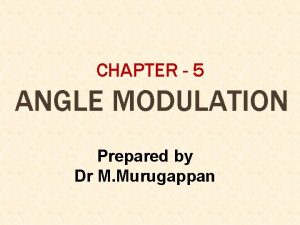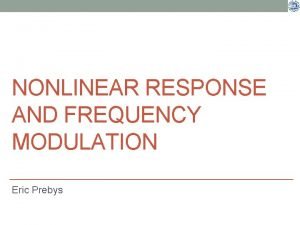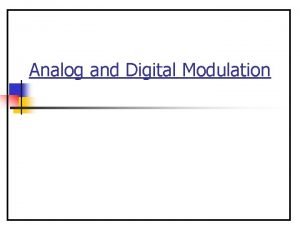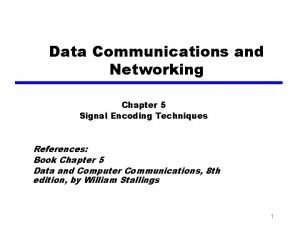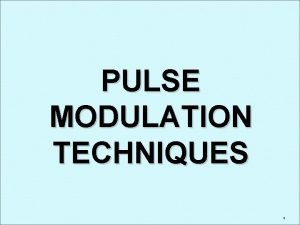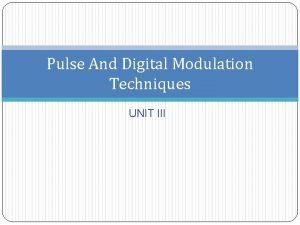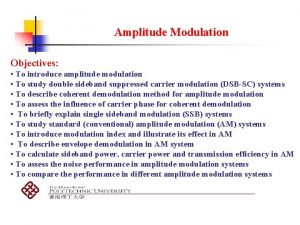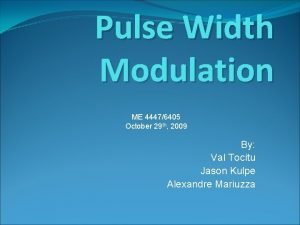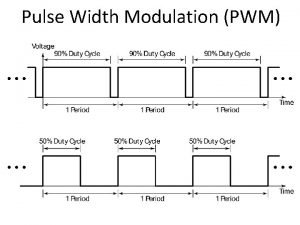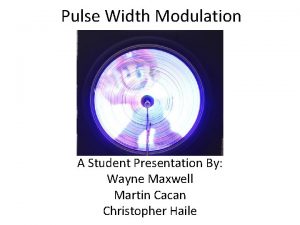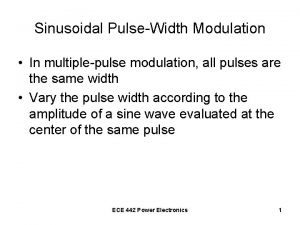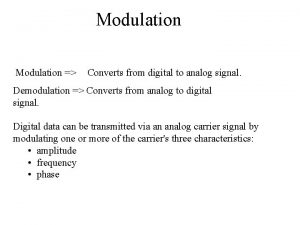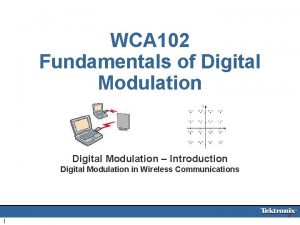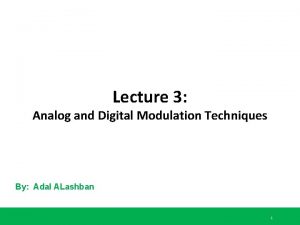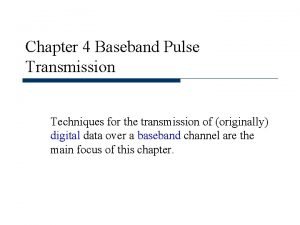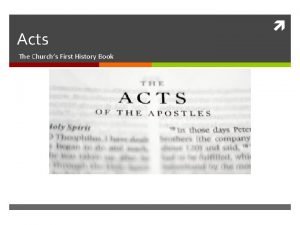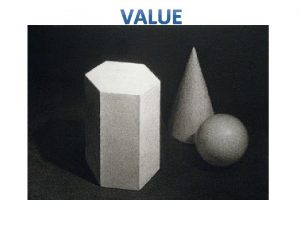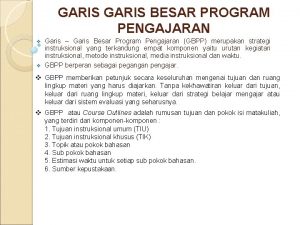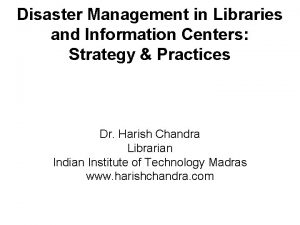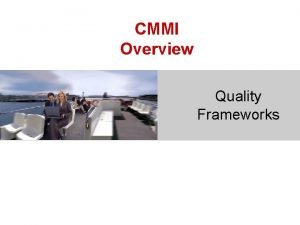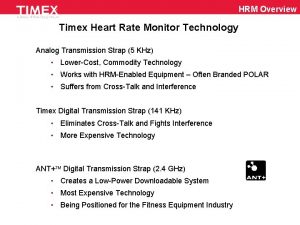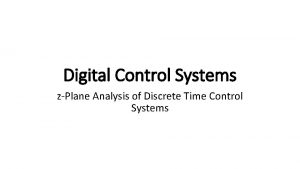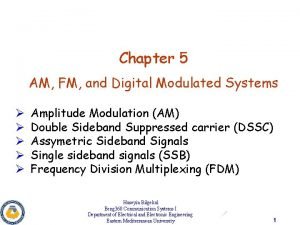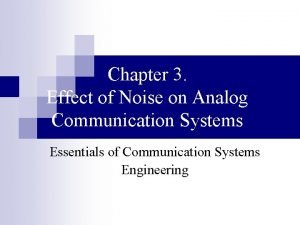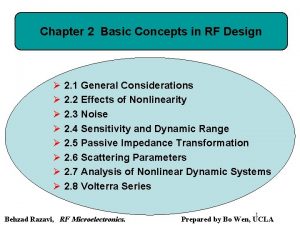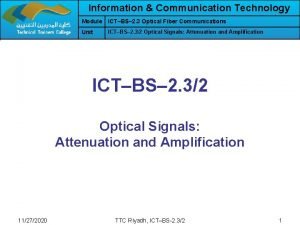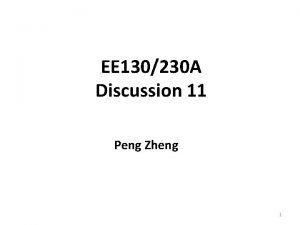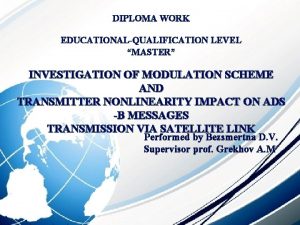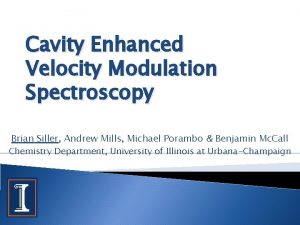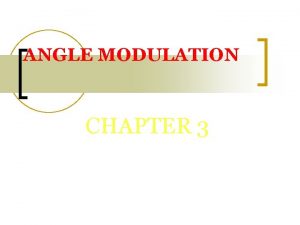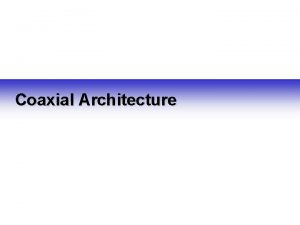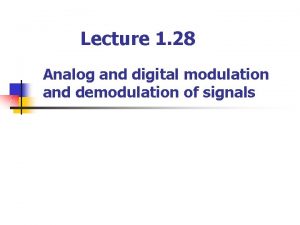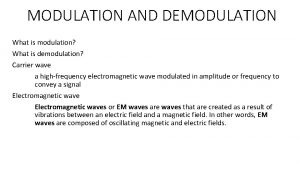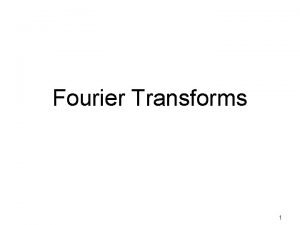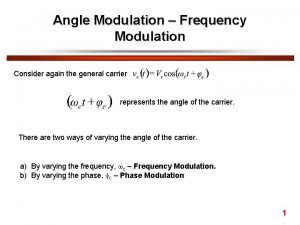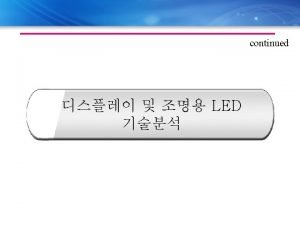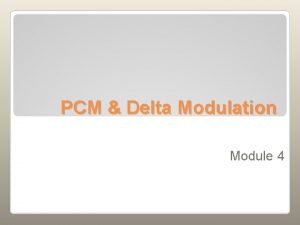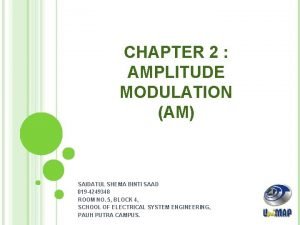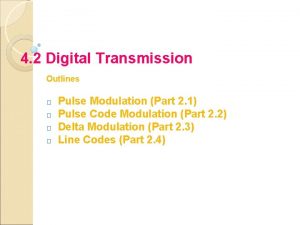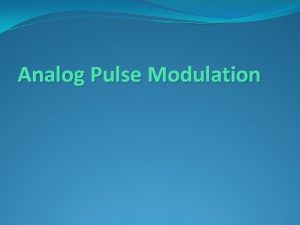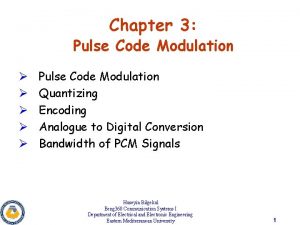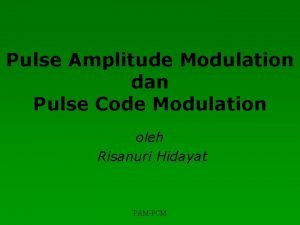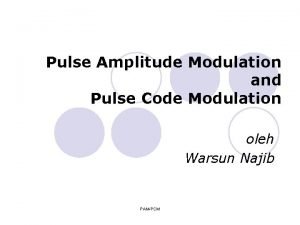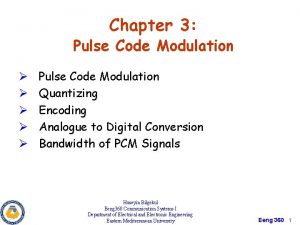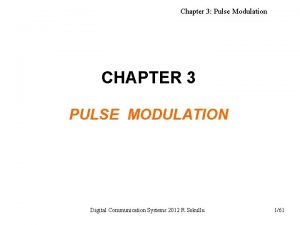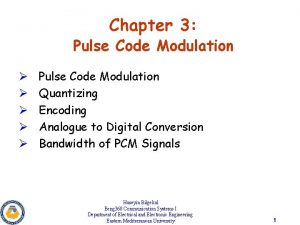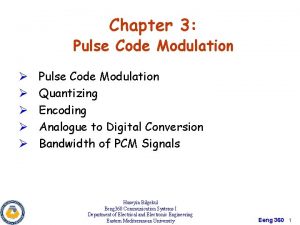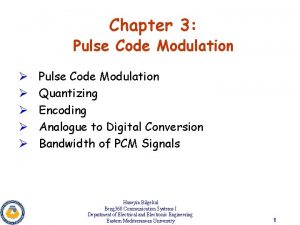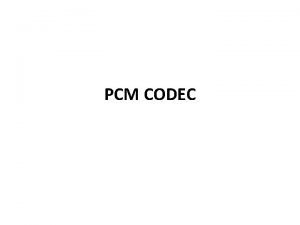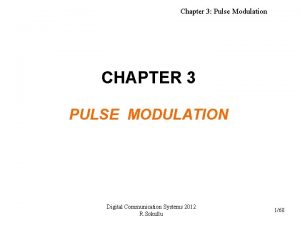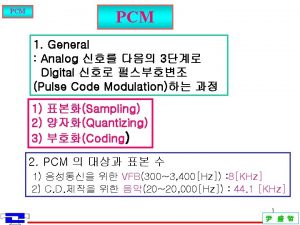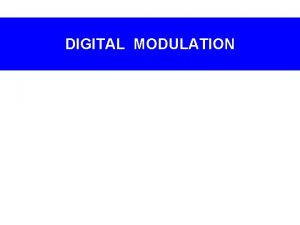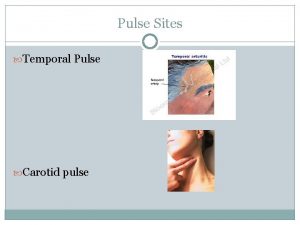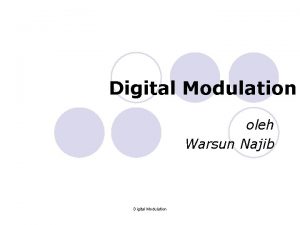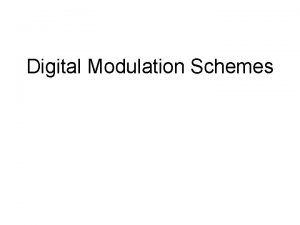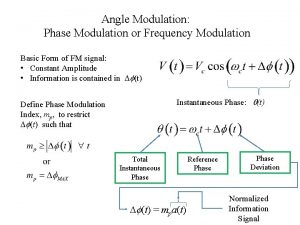4 2 Digital Transmission Outlines Pulse Modulation Pulse






























































- Slides: 62

4. 2 Digital Transmission Outlines □ □ Pulse Modulation Pulse Code Modulation Delta Modulation Line Codes

□ Sampling analog information signal □ Converting samples into discrete pulses □ Transport the pulses from source to destination over physical transmission medium.

Cont’d. . . □ Four (4) Methods 1. PAM 2. 3. 4. PWM PPM PCM Analog Pulse Modulation Digital Pulse Modulation

Cont’d. . . □ Analog Pulse Modulation □ Carrier signal is pulse waveform and the modulated signal is where one of the carrier signal’s characteristic (either amplitude, width or position) is changed according to information signal.

Pulse Amplitude Modulation (PAM) • The amplitude of pulses is varied in accordance with the information signal. • Width & position constant.

Pulse Width Modulation (PWM) □ Sometimes called Pulse Duration Modulation (PDM). □ The width of pulses is varied in accordance to information signal. □ Amplitude & position constant.

Cont’d. . .

• Pulse Position Modulation in which the temporal positions of the pulses are (PPM) varied in accordance with some characteristic of the information signal. • Amplitude & width constant.

Advantages & Drawbacks of Pulse Modulation □ Noise immunity. □ Relatively low cost digital circuitry. □ Able to be time division multiplexed with other pulse modulated signal. □ Storage of digital streams. □ Error detection & correction □ Requires greater BW to transmit & receive as compared to its analog counterpart. □ Special encoding & decoding methods must be used to increased transmission rates & more difficult to be recovered. □ Requires precise synchronization of clocks between Tx & Rx.

Sampling □ A process of taking samples of information signal at a rate of Nyquist’s sampling frequency. □ Nyquist’s Sampling Theorem : The original information signal can be reconstructed at the receiver with minimal distortion if the sampling rate in the pulse modulation system equal to or greater than twice the maximum information signal frequency. fs >= fm (max)

Cont’d. . . □ Two basic techniques used to perform the sampling function: □ Natural sampling □ Flat-top sampling

Natural Sampling □ Tops of the sample pulses retain their natural shape during the sample interval. □ Frequency spectrum of the sampled output is different from an ideal sample. □ Amplitude of frequency components produced from narrow, finite-width sample pulses decreases for the higher harmonics □ Requiring the use of frequency equalizers

Natural Sampling

Flat-top Sampling □ Common used in PCM systems. □ Accomplish in a sample-and-hold circuit □ To periodically sample the continually changing analog input voltage & convert to a series of constant-amplitude PAM voltage levels. □ The input voltage is sampled with a narrow pulse and then held relatively constant until the next sample is taken.

Cont’d… □ Sampling process alters the frequency spectrum & introduces aperture error. □ The amplitude of the sampled signal changes during the sample pulse time. □ Advantages: □ Introduces less aperture distortion □ Can operate with a slower ADC

Flat-top Sampling

□ Basic scheme of PCM system □ Quantization Error □ Companding □ Block diagram & function of TDM-PCM communication system

Basic scheme of PCM system □ The most common technique for using digital signals to encode analog data is PCM. □ Example: To transfer analog voice signals off a local loop to digital end office within the phone system, one uses a codec.

Cont’d. . . □ Because voice data limited to frequencies below 4000 Hz, a codec makes 8000 samples/sec. (i. e. , 125 microsecond/sample). □ If a signal is sampled at regular intervals at a rate higher than twice the highest signal frequency, the samples contain all the information of the original signal.

PCM Block Diagram • Most common form of analog to digital modulation • Four step process 1. Signal is sampled using PAM (Sample) 2. Integer values assigned to signal (PAM) 3. Values converted to binary (Quantized) 4. Signal is digitally encoded for transmission (Encoded)

4 Steps Process

Cont’d… □ Analog signal is sampled. □ Converted to discrete-time continuous-amplitude signal (Pulse Amplitude Modulation) □ Pulses are quantized and assigned a digital value. □ A 7 -bit sample allows 128 quantizing levels. □ PCM uses non-linear encoding, i. e. , amplitude spacing of levels is nonlinear □ There is a greater number of quantizing steps for low amplitude □ This reduces overall signal distortion. □ This introduces quantizing error (or noise). □ PCM pulses are then encoded into a digital bit stream. □ 8000 samples/sec x 7 bits/sample = 56 Kbps for a single voice channel.

PCM Example

Quantization □ A process of converting an infinite number of possibilities to a finite number of conditions (rounding off the amplitudes of flat -top samples to a manageable number of levels).

Cont’d. . . Analog input signal Sample pulse PAM signal PCM code

Cont’d… q The quantization interval @ quantum = the magnitude difference between adjacent steps. q The resolution = the magnitude of a quantum = the voltage of the minimum step size. q The quantization error = the quantization noise = ½ quantum = (orig. sample voltage – quantize level) q PCM code = (sample voltage/resolution)

QUANTIZATION ERROR □ A difference between the exact value of the analog signal & the nearest quantization level.

Types of Quantization Midtread Midrise

Types of Quantizer 1. Uniform type : The levels of the quantized amplitude are uniformly spaced. 2. Non-uniform type : The levels are not uniform.

Dynamic Range (DR) □ Largest possible magnitude/smallest possible magnitude. □ Where □ □ DR = absolute value of dynamic range Vmax = the maximum voltage magnitude Vmin = the quantum value (resolution) n = number of bits in the PCM code

Example 1 1. Calculate the dynamic range for a linear PCM system using 16 -bit quantizing. 2. Calculate the number of bits in PCM code if the DR = 192. 6 d. B

Coding Efficiency □ A numerical indication of how efficiently a PCM code is utilized. □ The ratio of the minimum number of bits required to achieve a certain dynamic range to the actual number of PCM bits used. Coding Efficiency = Minimum number of bits x 100 Actual number of bits

Signal to Quantization Noise Ratio (SQR) □ The worst-case voltage SQR R =resistance (ohm) v = rms signal voltage □ SQR for a maximum input signal q = quantization interval □ The signal power-to-quantizing noise power ratio

Example 2 1. 2. Calculate the SQR (d. B) if the input signal = 2 Vrms and the quantization noise magnitudes = 0. 02 V. Determine the voltage of the input signals if the SQR = 36. 82 d. B and q =0. 2 V.

Effect of Non-Linear Coding

Nonlinear Encoding □ Quantization levels not evenly spaced □ Reduces overall signal distortion □ Can also be done by companding

Companding • The process of compressing and then expanding. • The higher amplitude analog signals are compressed prior to transmission and then expanded in receiver. • Improving the DR of a communication system.

Companding Functions

Method of Companding □ For the compression, two laws are adopted: the -law in US and Japan and the A-law in Europe. □ -law □ □ A-law Vmax= Max uncompressed analog input voltage Vin= amplitude of the input signal at a particular of instant time Vout= compressed output amplitude A, = parameter define the amount of compression □ The typical values used in practice are: =255 and A=87. 6. □ After quantization the different quantized levels have to be represented in a form suitable for transmission. This is done via an encoding process.

Example 3 □ A companding system with µ = 255 used to compand from 0 V to 15 V sinusoid signal. Draw the characteristic of the typical system. □ Draw an 8 level non-uniform quantizer characteristic that corresponds to the mentioned µ.

Cont’d. . . μ-law A-law

PCM Line Speed □ The data rate at which serial PCM bits are clocked out of the PCM encoder onto the transmission line. □ Where □ Line speed = the transmission rate in bits per second □ Sample/second = sample rate, fs □ Bits/sample = no of bits in the compressed PCM code

Example 4 □ For a single PCM system with a sample rate fs = 6000 samples per second a 7 bits compressed PCM code, calculate the line speed.

Virtues & Limitation of PCM The most important advantages of PCM are: □ Robustness to channel noise and interference. □ Efficient regeneration of the coded signal along the channel path. □ Efficient exchange between BT and SNR. □ Uniformat for different kind of base-band signals. □ Flexible TDM.

Cont’d… □ Secure communication through the use of special modulation schemes of encryption. □ These advantages are obtained at the cost of more complexity and increased BT. □ With cost-effective implementations, the cost issue no longer a problem of concern. □ With the availability of wide-band communication channels and the use of sophisticated data compression techniques, the large bandwidth is not a serious problem.

Time-Division Multiplexing □ This technique combines time-domain samples from different message signals (sampled at the same rate) and transmits them together across the same channel. □ The multiplexing is performed using a commutator (switch). At the receiver a decommutator (switch) is used in synchronism with the commutator to demultiplex the data.

Cont’d… □ TDM system is very sensitive to symbol dispersion, that is, to variation of amplitude with frequency or lack of proportionality of phase with frequency. This problem may be solved through equalization of both magnitude and phase. □ One of the methods used to synchronize the operations of multiplexing and demultiplexing is to organize the multiplexed stream of data as frames with a special pattern. The pattern is known to the receiver and can be detected very easily.

Block diagram of TDM-PCM communication system

□ Converting standard logic level to a form more suitable to telephone line transmission. □ The line codes properties: 1. Transmission BW should be small as possible 2. Efficiency should be as high as possible 3. Error detection & correction capability 4. Transparency (Encoded signal is received faithfully)

Cont’d. . . □ Six factors must be considered when selecting a line encoding format; 1. transmission voltage & DC component 2. Duty cycle 3. Bandwidth consideration 4. Clock and framing bit recovery 5. Error detection 6. Ease of detection and decoding

Why Digital Signaling? □ Low cost digital circuits □ The flexibility of the digital approach (because digital data from digital sources may be merged with digitized data derived from analog sources to provide general purpose communication system)

Digital Modulation □ Using Digital Signals to Transmit Digital Data □ Bits must be changed to digital signal for transmission □ Unipolar encoding □ Positive or negative pulse used for zero or one □ Polar encoding □ Uses two voltage levels (+ and - ) for zero or one □ Bipolar encoding □ +, -, and zero voltage levels are used

Non-Return to Zero-Level (NRZ-L) □ Two different voltages for 0 and 1 bits. □ Voltage constant during bit interval. □ no transition, no return to zero voltage □ More often, negative voltage for one value and positive for the other.

Non-Return to Zero Inverted (NRZ-I) □ Nonreturn to zero inverted on ones □ Constant voltage pulse for duration of bit □ Data encoded as presence or absence of signal transition at beginning of bit time □ Transition (low to high or high to low) denotes a binary 1 □ No transition denotes binary 0 □ An example of differential encoding

Multilevel Binary(Bipolar-AMI) • • zero represented by no line signal one represented by positive or negative pulse one pulses alternate in polarity No loss of sync if a long string of ones (zeros still a problem) • No net dc component • Lower bandwidth • Easy error detection 0 1 0 0 1 1 0 0 0 1 1

Pseudoternary □ One represented by absence of line signal □ Zero represented by alternating positive and negative □ No advantage or disadvantage over bipolar-AMI 0 1 0 0 1 1 0 0 0 1 1

Manchester □ There is always a mid-bit transition {which is used as a clocking mechanism}. □ The direction of the mid-bit transition represents the digital data. □ 1 low-to-high transition □ 0 high-to-low transition □ Consequently, there may be a second transition at the beginning of the bit interval. □ Used in 802. 3 baseband coaxial cable and CSMA/CD twisted pair.


Differential Manchester □ mid-bit transition is ONLY for clocking. □ 1 absence of transition at the beginning of the bit interval □ 0 presence of transition at the beginning of the bit interval □ Differential Manchester is both differential and biphase. [Note – the coding is the opposite convention from NRZI. ] □ Used in 802. 5 (token ring) with twisted pair. □ * Modulation rate for Manchester and Differential Manchester is twice the data rate inefficient encoding for long-distance applications.


Example 5 □ Sketch the data wave form for a bit stream 11010 using □ NRZL □ Bipolar AMI □ Pseudoternary

END OF PART 2
 Advantages of angle modulation
Advantages of angle modulation Amplitude modulation vs frequency modulation
Amplitude modulation vs frequency modulation Amplitude modulation vs frequency modulation
Amplitude modulation vs frequency modulation Pcm pulse code modulation
Pcm pulse code modulation Pulse code modulation and demodulation
Pulse code modulation and demodulation Pulse code modulation conclusion
Pulse code modulation conclusion Pulse code modulation conclusion
Pulse code modulation conclusion Manchester encoding scheme
Manchester encoding scheme Amplitude modulation conclusion
Amplitude modulation conclusion Advantage of pulse width modulation
Advantage of pulse width modulation Advantages and disadvantages of pulse code modulation
Advantages and disadvantages of pulse code modulation Pwm
Pwm Pwmctl
Pwmctl Multiple pulse width modulation
Multiple pulse width modulation Modulation digital to analog
Modulation digital to analog Digital modulation advantages
Digital modulation advantages Analog and digital modulation techniques
Analog and digital modulation techniques Baseband pulse transmission
Baseband pulse transmission Commercial law outline
Commercial law outline Mun position paper outline
Mun position paper outline 2 kings 4 8 17
2 kings 4 8 17 Coordination outlining
Coordination outlining Ksf outlines
Ksf outlines Outline of the book of acts
Outline of the book of acts Four main components for effective outlines
Four main components for effective outlines Define:visible
Define:visible Anime outline character
Anime outline character Teaching outlines
Teaching outlines Exegetical outline
Exegetical outline A business plan is a document that outlines
A business plan is a document that outlines Catarrhal appendicitis
Catarrhal appendicitis Two types of outlines
Two types of outlines Mucoepidermoid carcinoma histology
Mucoepidermoid carcinoma histology Kairos program manual
Kairos program manual Cjis security & awareness certification
Cjis security & awareness certification Pathology outline
Pathology outline Disaster management in libraries and information centres
Disaster management in libraries and information centres Summary of a haunted house by virginia woolf
Summary of a haunted house by virginia woolf Cmmi model outlines
Cmmi model outlines Timex fitness hrm
Timex fitness hrm Data encoding and transmission
Data encoding and transmission Digital vs analog transmission
Digital vs analog transmission Analogue and digital transmission in computer networks
Analogue and digital transmission in computer networks Pulse transfer function in digital control system
Pulse transfer function in digital control system Ussb signal
Ussb signal Thermal noise in analog communication
Thermal noise in analog communication Cross modulation
Cross modulation Epigenetic modulation
Epigenetic modulation Direct modulation
Direct modulation Tina champagne
Tina champagne Channel length modulation
Channel length modulation Ads b modulation
Ads b modulation Cevms
Cevms Angle modulation formula
Angle modulation formula Cross modulation
Cross modulation Define modulation index
Define modulation index Modulation and demodulation
Modulation and demodulation Inverse fourier transform table
Inverse fourier transform table Frequency modulation equation
Frequency modulation equation Modulation doping
Modulation doping Granular noise formula
Granular noise formula Formula for modulation index
Formula for modulation index Average value of signal
Average value of signal
